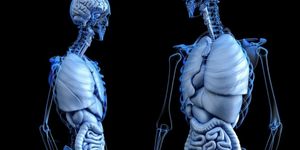New Connection Between Receptors Discovered in the Brain
Researchers at Tufts University School of Medicine have reported the discovery of a novel signaling pathway, and the findings may have implications for the treatment of schizophrenia. Two important molecules in the brain that have been associated with learning and memory are the N-methyl-D-aspartate receptor (NMDAR) and the alpha 7 nicotinic acetylcholine receptor (a7nAChR). This work, published in Neuron and described in the video, indicates that a special type of non-neuronal cell in the brain, astrocytes, link these receptors.
"The NMDAR is the most investigated receptor in neuroscience because it is essential to synaptic plasticity, which is instrumental in establishing and remodeling brain circuitry and is thought to be the cellular foundation of learning and memory," explained lead author of the report Thomas Papouin, Ph.D., Research Assistant Professor at Tufts School of Medicine. "The NMDAR is known to be activated by two chemicals: glutamate, which is supplied by neurons, and D-serine, which is supplied by astrocytes. While most research is focused on the role that neurons play in activating the NMDAR via glutamate, we focused on the role played by astrocytes through the release of D-serine."
The researchers utilized a mouse model and in vitro techniques and found that astrocytes modulate the levels of D-serine release in response to wakefulness, something the astrocytes monitor directly. For that, the cells use a7nAChR to sense the level of acetylcholine, which is released in the brains of both humans and rodents during wakefulness. If a mouse was more active, the investigators observed that higher levels of D-serine were released by the astrocytes, which promoted the activation of NMDARs. That was true whether the mice were active as part of a normal routine, or stimulated to be active during unusual times.
"Astrocytes act like the dimmer control of a light," Papouin explained. "When the neuronal switch goes on, and glutamate is released, the setting of the astrocytic D-serine 'dimmer' determines the intensity of the NMDAR signal. During wakefulness, this dimmer is set on high - astrocytes provide a lot of D-serine - and this allows for a strong NMDAR signal. But during sleep or inactivity, it is set on low, allowing for a weaker signal."
This work could help provide a new way to approach the treatment of schizophrenia and may open new avenues for therapeutics.
"This is an exciting finding with direct relevance to development of new treatments for schizophrenia, which is characterized by low levels of D-serine and diminished NMDAR as well as a major loss of cholinergic function. Efforts to develop pharmaceuticals to address these deficits have so far been unsuccessful, but in our study we were able to enhance NMDAR function via D-serine by stimulating a7nAChRs with a drug that has been part of recent stage 3 clinical trials for schizophrenia," said corresponding author Philip G. Haydon, Ph.D., the Annetta and Gustav Grisard professor and chair of the Department of Neuroscience at Tufts School of Medicine. "This suggests that cholinergic drugs now under development for schizophrenia work through this newly discovered astrocytic pathway."
Sources: AAAS/Eurekalert! via Tufts University, Neuron









